GMC SONOMA 2000 Workshop Manual
Manufacturer: GMC, Model Year: 2000, Model line: SONOMA, Model: GMC SONOMA 2000Pages: 381, PDF Size: 2.65 MB
Page 51 of 381
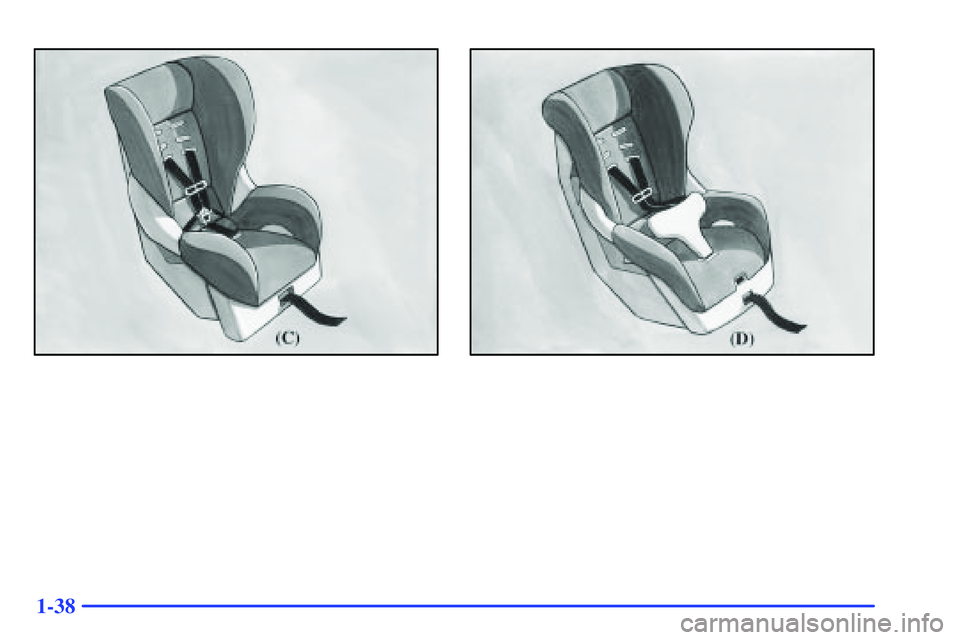
1-38
Page 52 of 381
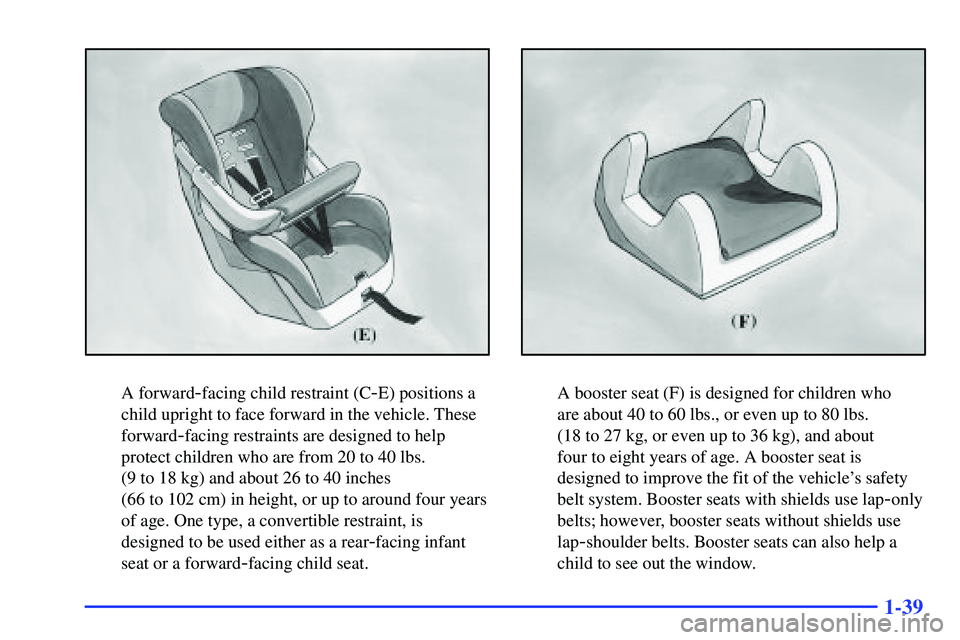
1-39
A forward-facing child restraint (C-E) positions a
child upright to face forward in the vehicle. These
forward
-facing restraints are designed to help
protect children who are from 20 to 40 lbs.
(9 to 18 kg) and about 26 to 40 inches
(66 to 102 cm) in height, or up to around four years
of age. One type, a convertible restraint, is
designed to be used either as a rear
-facing infant
seat or a forward
-facing child seat.
A booster seat (F) is designed for children who
are about 40 to 60 lbs., or even up to 80 lbs.
(18 to 27 kg, or even up to 36 kg), and about
four to eight years of age. A booster seat is
designed to improve the fit of the vehicle's safety
belt system. Booster seats with shields use lap
-only
belts; however, booster seats without shields use
lap
-shoulder belts. Booster seats can also help a
child to see out the window.
Page 53 of 381
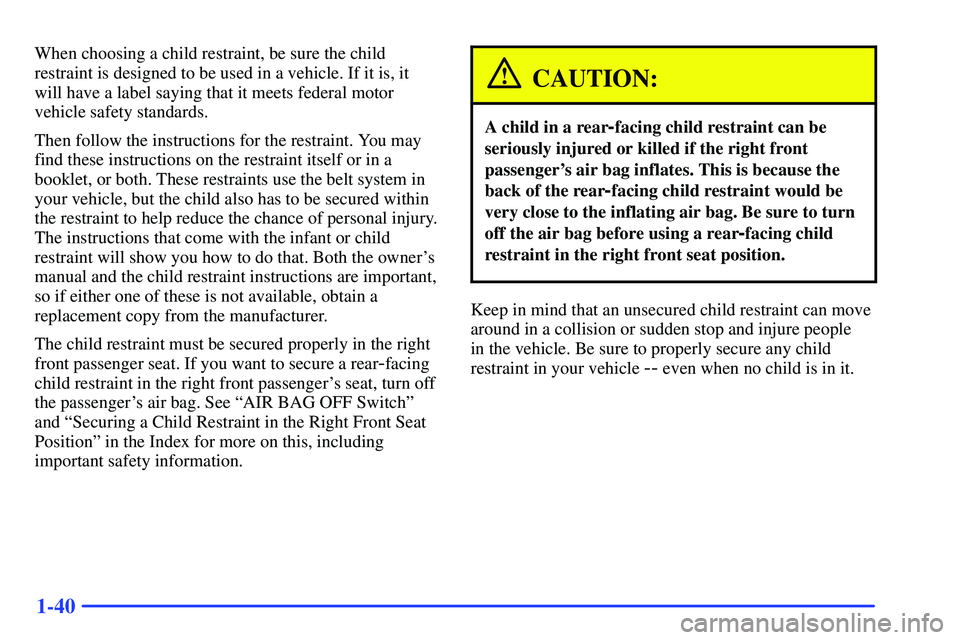
1-40
When choosing a child restraint, be sure the child
restraint is designed to be used in a vehicle. If it is, it
will have a label saying that it meets federal motor
vehicle safety standards.
Then follow the instructions for the restraint. You may
find these instructions on the restraint itself or in a
booklet, or both. These restraints use the belt system in
your vehicle, but the child also has to be secured within
the restraint to help reduce the chance of personal injury.
The instructions that come with the infant or child
restraint will show you how to do that. Both the owner's
manual and the child restraint instructions are important,
so if either one of these is not available, obtain a
replacement copy from the manufacturer.
The child restraint must be secured properly in the right
front passenger seat. If you want to secure a rear
-facing
child restraint in the right front passenger's seat, turn off
the passenger's air bag. See ªAIR BAG OFF Switchº
and ªSecuring a Child Restraint in the Right Front Seat
Positionº in the Index for more on this, including
important safety information.
CAUTION:
A child in a rear-facing child restraint can be
seriously injured or killed if the right front
passenger's air bag inflates. This is because the
back of the rear
-facing child restraint would be
very close to the inflating air bag. Be sure to turn
off the air bag before using a rear
-facing child
restraint in the right front seat position.
Keep in mind that an unsecured child restraint can move
around in a collision or sudden stop and injure people
in the vehicle. Be sure to properly secure any child
restraint in your vehicle
-- even when no child is in it.
Page 54 of 381
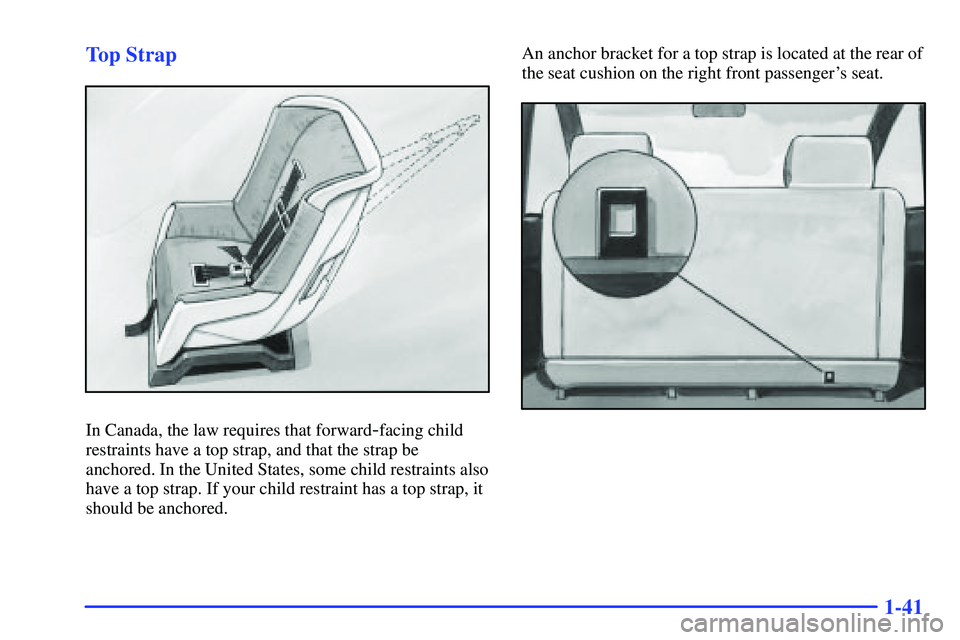
1-41 Top Strap
In Canada, the law requires that forward-facing child
restraints have a top strap, and that the strap be
anchored. In the United States, some child restraints also
have a top strap. If your child restraint has a top strap, it
should be anchored.An anchor bracket for a top strap is located at the rear of
the seat cushion on the right front passenger's seat.
Page 55 of 381
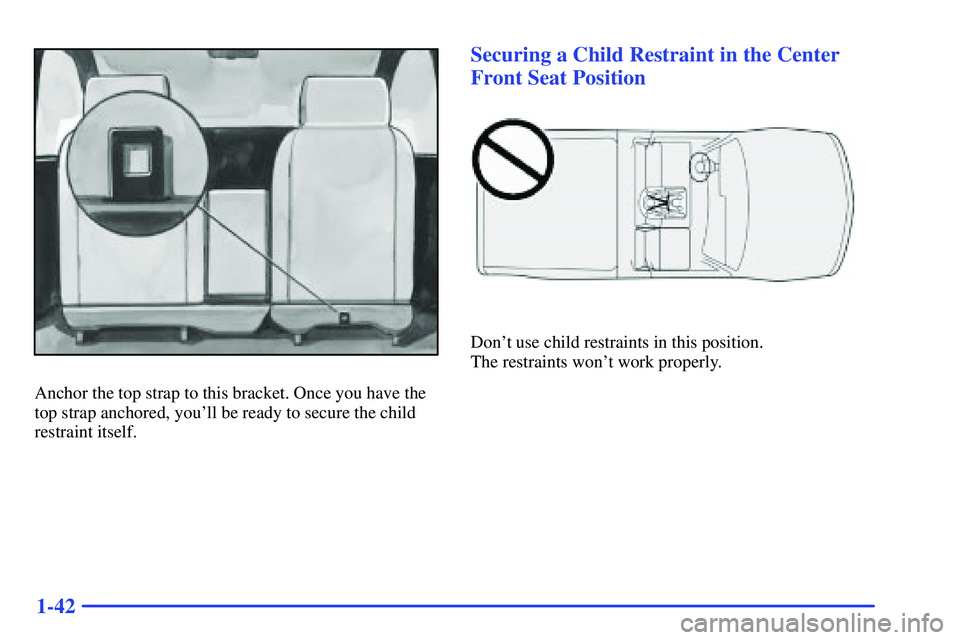
1-42
Anchor the top strap to this bracket. Once you have the
top strap anchored, you'll be ready to secure the child
restraint itself.
Securing a Child Restraint in the Center
Front Seat Position
Don't use child restraints in this position.
The restraints won't work properly.
Page 56 of 381
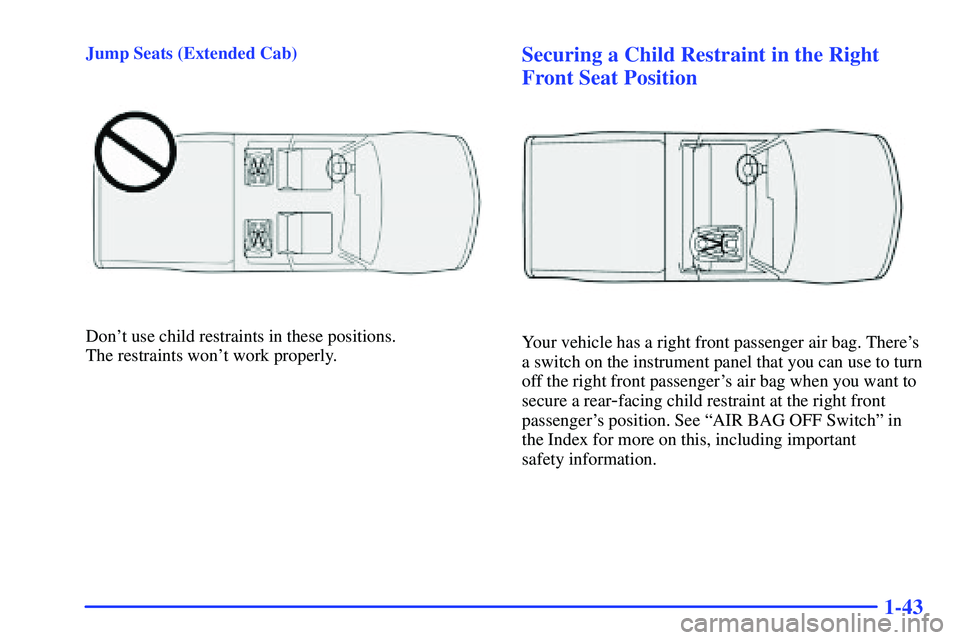
1-43
Jump Seats (Extended Cab)
Don't use child restraints in these positions.
The restraints won't work properly.
Securing a Child Restraint in the Right
Front Seat Position
Your vehicle has a right front passenger air bag. There's
a switch on the instrument panel that you can use to turn
off the right front passenger's air bag when you want to
secure a rear
-facing child restraint at the right front
passenger's position. See ªAIR BAG OFF Switchº in
the Index for more on this, including important
safety information.
Page 57 of 381
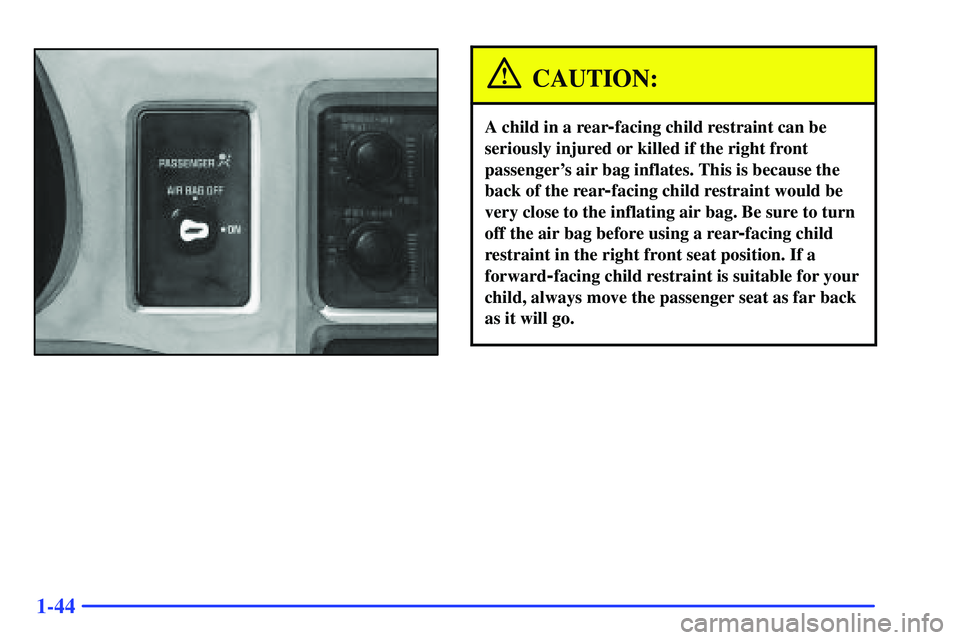
1-44
CAUTION:
A child in a rear-facing child restraint can be
seriously injured or killed if the right front
passenger's air bag inflates. This is because the
back of the rear
-facing child restraint would be
very close to the inflating air bag. Be sure to turn
off the air bag before using a rear
-facing child
restraint in the right front seat position. If a
forward
-facing child restraint is suitable for your
child, always move the passenger seat as far back
as it will go.
Page 58 of 381
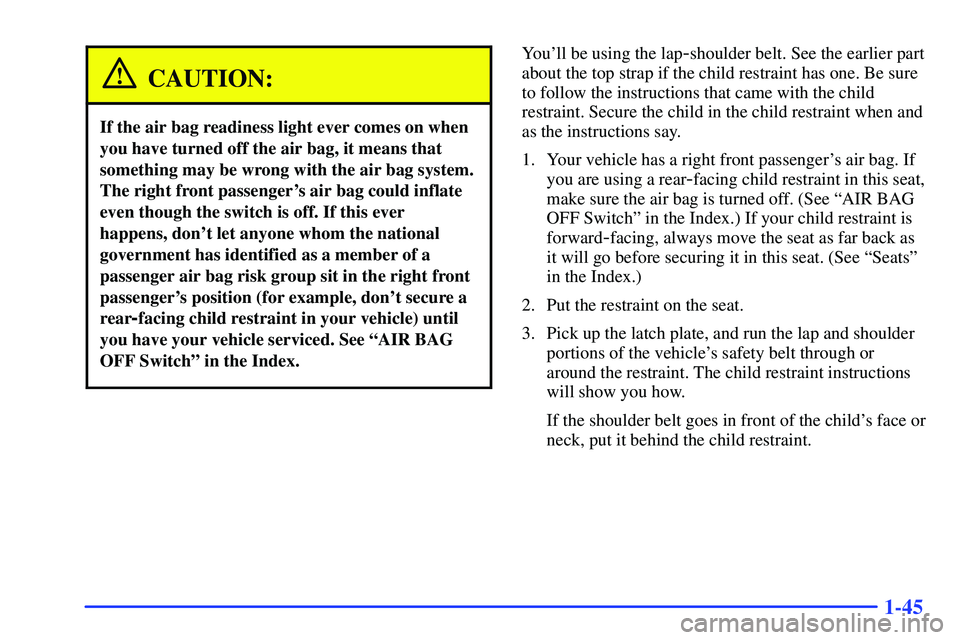
1-45
CAUTION:
If the air bag readiness light ever comes on when
you have turned off the air bag, it means that
something may be wrong with the air bag system.
The right front passenger's air bag could inflate
even though the switch is off. If this ever
happens, don't let anyone whom the national
government has identified as a member of a
passenger air bag risk group sit in the right front
passenger's position (for example, don't secure a
rear
-facing child restraint in your vehicle) until
you have your vehicle serviced. See ªAIR BAG
OFF Switchº in the Index.
You'll be using the lap-shoulder belt. See the earlier part
about the top strap if the child restraint has one. Be sure
to follow the instructions that came with the child
restraint. Secure the child in the child restraint when and
as the instructions say.
1. Your vehicle has a right front passenger's air bag. If
you are using a rear
-facing child restraint in this seat,
make sure the air bag is turned off. (See ªAIR BAG
OFF Switchº in the Index.) If your child restraint is
forward
-facing, always move the seat as far back as
it will go before securing it in this seat. (See ªSeatsº
in the Index.)
2. Put the restraint on the seat.
3. Pick up the latch plate, and run the lap and shoulder
portions of the vehicle's safety belt through or
around the restraint. The child restraint instructions
will show you how.
If the shoulder belt goes in front of the child's face or
neck, put it behind the child restraint.
Page 59 of 381
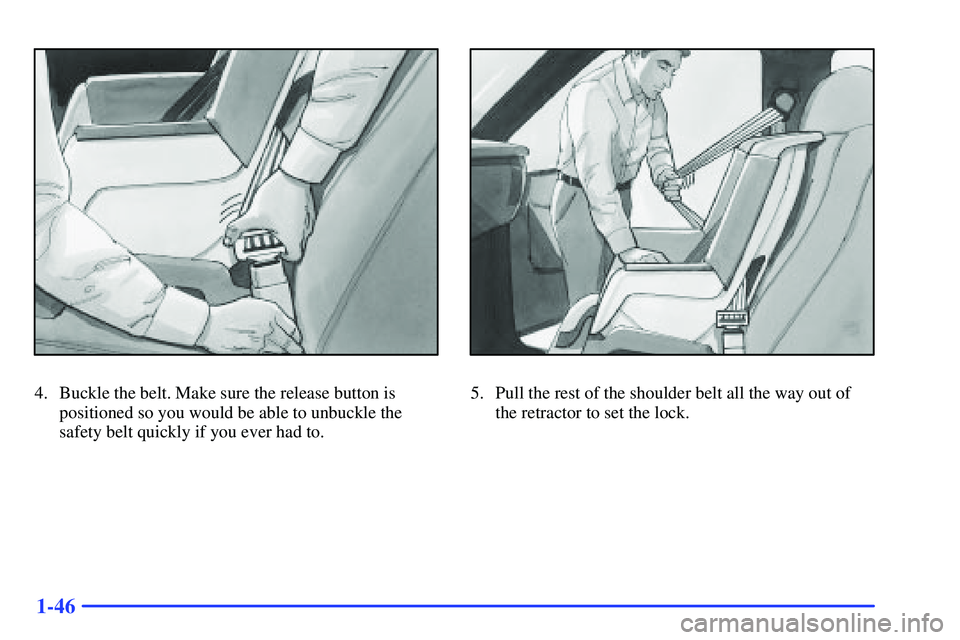
1-46
4. Buckle the belt. Make sure the release button is
positioned so you would be able to unbuckle the
safety belt quickly if you ever had to.5. Pull the rest of the shoulder belt all the way out of
the retractor to set the lock.
Page 60 of 381
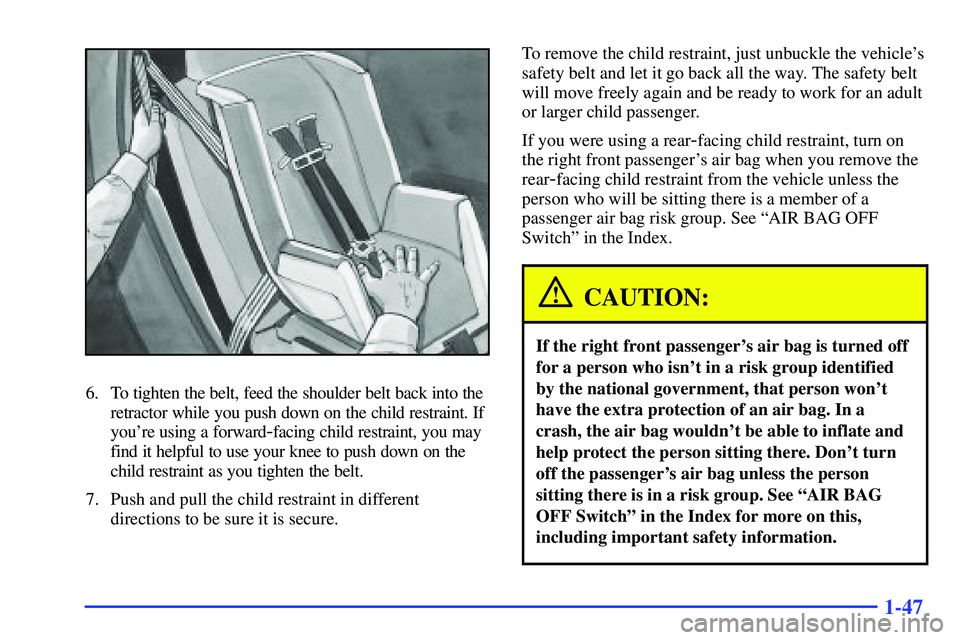
1-47
6. To tighten the belt, feed the shoulder belt back into the
retractor while you push down on the child restraint. If
you're using a forward
-facing child restraint, you may
find it helpful to use your knee to push down on the
child restraint as you tighten the belt.
7. Push and pull the child restraint in different
directions to be sure it is secure.To remove the child restraint, just unbuckle the vehicle's
safety belt and let it go back all the way. The safety belt
will move freely again and be ready to work for an adult
or larger child passenger.
If you were using a rear
-facing child restraint, turn on
the right front passenger's air bag when you remove the
rear
-facing child restraint from the vehicle unless the
person who will be sitting there is a member of a
passenger air bag risk group. See ªAIR BAG OFF
Switchº in the Index.
CAUTION:
If the right front passenger's air bag is turned off
for a person who isn't in a risk group identified
by the national government, that person won't
have the extra protection of an air bag. In a
crash, the air bag wouldn't be able to inflate and
help protect the person sitting there. Don't turn
off the passenger's air bag unless the person
sitting there is in a risk group. See ªAIR BAG
OFF Switchº in the Index for more on this,
including important safety information.